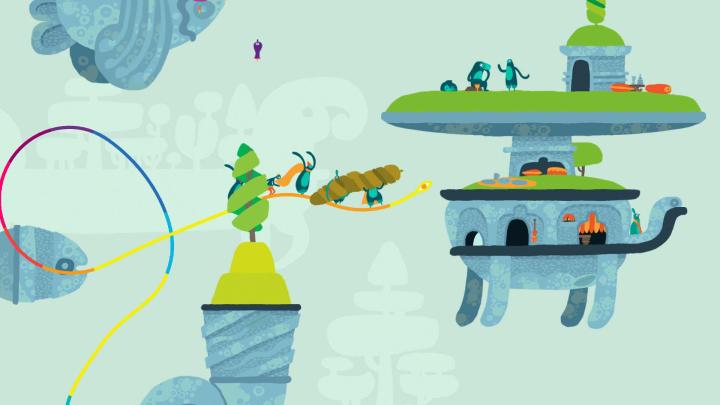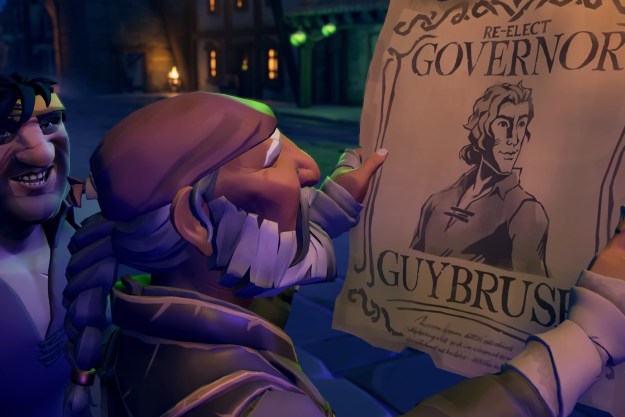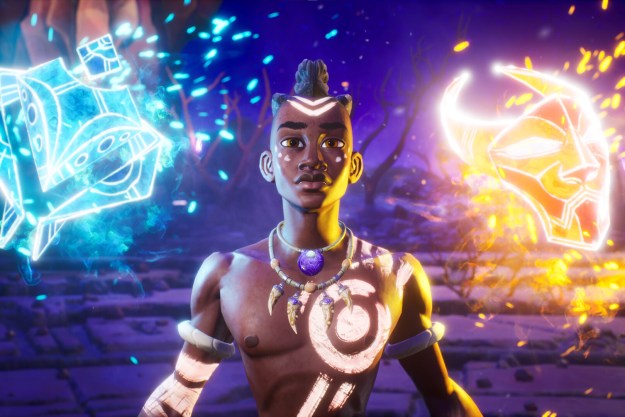
The artistry at play in Hohokum immediately catches the eye, encouraging you to stare after a mere glance. It’s a creative vision led by the shared efforts of UK artist Richard Hogg and indie developer Honeyslug, the same forces that aligned to deliver the PlayStation Vita’s free-to-play minigame collection Frobisher Says. Hohokum is chronologically the first full game that Hogg paired with Ricky Haggett’s small studio for, even though Frobisher preceded it.
“We started this game before Frobisher Says was ever an idea,” Hogg tells Digital Trends. “This is 2011, and we were in San Francisco [to present Hohokum] for the IGF when we wrote the pitch for Frobisher. I typed it up on the plane on the way back. Then, when we got that job, we put Hohokum on hold for a year to make Frobisher Says and then we went back to it.”
“… sometimes I’ll draw stuff and I don’t even know what it’s going to be in the game.”
You can see the DNA of Hogg’s artistic vision for Hohokum in Frobisher, as well as in Poto and Cabenga, the Flash game that bred the first collaboration between Hogg and Haggett. “There used to be a thing called Gamma which was organized by a collective who were based in Montreal, Canada who were like an indie game collective,” the artist says. “The year we entered, the theme was one button. Your game had to be controlled with just one button. And we made this game called Poto and Cabenga where you’re supposed to control two characters simultaneously with one button.”
Hogg went into that experience as a fan of mainstream games “of quality,” he says, citing Halo and a number of others, but he came out of it as an indie developer, his eyes newly opened. He and Haggett had been friends prior to Gamma, and the Honeyslug founder invited his artist friend to help build something during the brief two-week run-up to the competition. That was Hogg’s first taste of game development, and while he continues to maintain a thriving career outside of his work with Honeyslug, the collaborative efforts have been consistent enough for a regular working routine to develop.

“We have a kind of informal relationship. It’s kind of 50/50. I have as much say in that as I want, really. And I tend to have quite a lot of say in that,” Hogg says of his involvement in Honeyslug’s design process. “All of the ideas in terms of what actually happens in the game and the kind of feeling we want for the game and our ideas about the music, stuff like that, is pretty much joint. The only area where I tend to step back a little bit is when it gets down into the nitty-gritty of gameplay and puzzle mechanics, because I don’t have a very good brain for that kind of stuff.”
This is where the Honeyslug team’s talents are critical. The controls and objectives are set up in such a way that players feel constant encouragement to experiment, and that design philosophy is mirrored in Hogg’s and Haggett’s own creative process. “We are very conscious of making the game in a playful way,” the artist says. “Even at the moment, we’re well over halfway into our schedule of making the game… me and Ricky are constantly talking about keeping it fun and fresh in the way that we make it.”
“So one thing that we do all the time, which we’ve always done right from the start: sometimes I’ll draw stuff and I don’t even know what it’s going to be in the game. And I’ll give it to Ricky and say ‘Do something with that.’ And he’ll take it and he’ll play around with making it do something in the game. Sometimes it’s the opposite way around. Sometimes he’ll have an idea for something and he’ll build it using really bad art, just boxes, colored boxes. And then he’ll send me that and say, ‘Do you want to make this look nice.’ So we’re kind of working both ways.”

Hogg and his Honeyslug cohorts went in with a specific goal for Hohokum: give the player a creative outlet through play. “Obviously it’s not creative in the sense that you’re drawing and making stuff, like Minecraft is,” Hogg tells us. “It’s creative in the way that flying a kite is, or snowboarding, or something like that. It’s got an expressive quality that exists in the moment.”
The Long Mover punctuates Hogg’s point, a twisting and turning rainbow-snake-thing that bends and sways through the air with only slight adjustments to the analog stick. The control responsiveness is immediate and the Long Mover sets a rapid pace, two elements that work together to create a satisfying hook. Hohokum has goals in each “world” you visit that aren’t explicitly stated, and it’s easy to become distracted from trying to figure out your next move as the twisting Long Mover weaves hypnotic patterns under your direction.
“It’s creative in the way that flying a kite is, or snowboarding, or something like that. It’s got an expressive quality that exists in the moment.”
“We wanted a name that doesn’t say ‘snake’ or ‘worm.’ We wanted a name that was more ambiguous than that,” Hogg continues. “It almost sounds like maybe somebody in this world sees you as an almost mythical thing or deity-like creature, and that’s the name they’ve given you. Like when Westerners first brought horses to North America, some of the [native American] words that translate as something like ‘long dog’ or ‘dog with man on it.'”

Hohokum‘s striking visual style is in part simply a product of the artistic impulses that Hogg has spent his career honing. His earlier collaborations with Haggett share similar sensibilities, though the upcoming gaming is also guided by more specific concepts. “One idea that we have, that I’m really into when I draw the stuff for Hohokum, is mixing metaphors. Making things familiar but unfamiliar at the same time, in a mixed up way.”
That’s a guiding philosophy for what you can see in Hohokum. What you can’t see, and what neither Hogg nor Honeyslug will talk about until after the game’s release, is the story. It’s not immediately apparent, but there is an underlying narrative structure in the game, something for players to latch onto that ties together the disparate experiences in each world.
“It’s not heavy-handed. It’s something which you might almost not notice the whole time you’re playing the game. But then you might notice it and realize what’s happening, and hopefully that’s a delightful thing for the player to realize,” Hogg says of the story. “We’re not going to say anything about it until the game comes out. We’re not going to blow people’s minds; it’s just a nice thing that ties everything together.”


